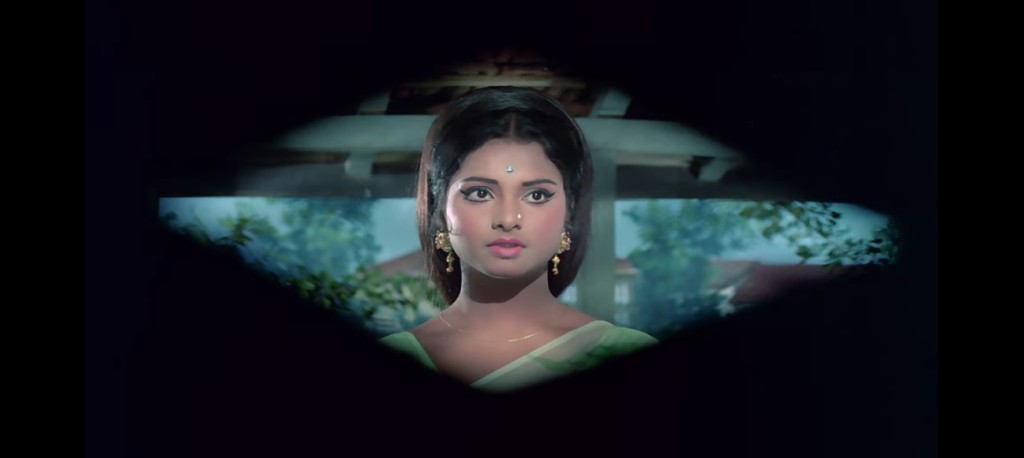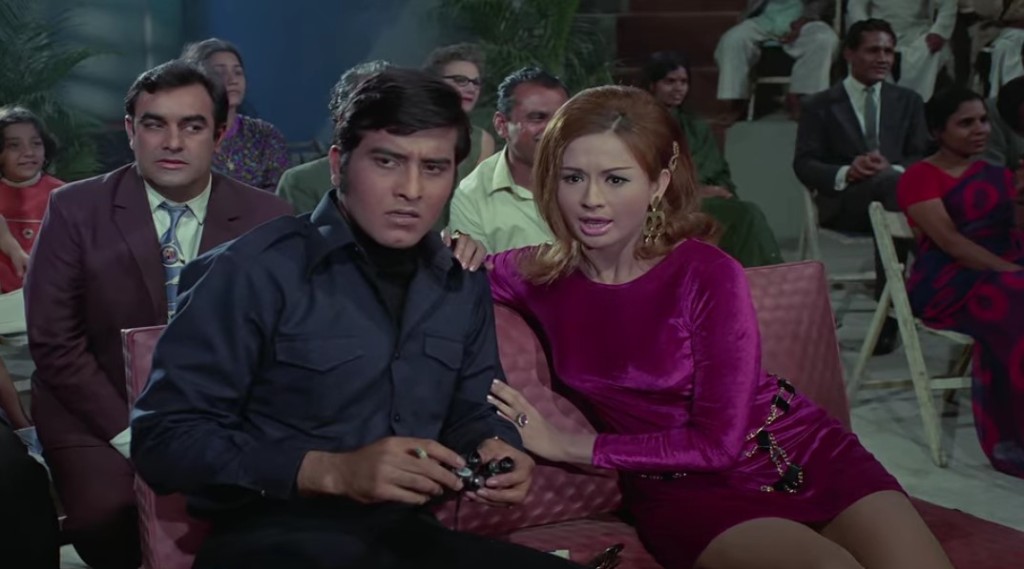Readers will be unsurprised to learn that Rekha’s birthday is something of an annual holiday in my household. Elaan was the entertainment on offer during this past year’s festivities. I found it a freewheeling, pleasantly louche delight for the senses—untidy, perhaps, but supremely enjoyable. Though it drags in the middle, to complain about such a film would mark me an ingrate. There are adorably strange science-fiction-y elements, a heroine whose response to her father’s murder is to become a spy about it, not one but two luxuriously decorated murder lairs, and (most of all, by my lights) Vinod K. and Helen as a pair of in-cahoots spanners in the works. Elaan was produced by F. C. Mehra for Eagle Films/United Producers and directed by K. Raman Lal. The story is by Umesh with screenplay and dialogues by Vrajendra Gaur. And look, look:

Happy sixty-eighth, Rekha ma’am!
Naresh (Vinod Mehra) lands a steady job at the weekly newspaper Sangram in the traditional manner of freelance photojournalists: by happening to be bumming around the beach at an opportune time. Among his early assignments from editor Haran Mehta (Brahm Bhardwaj) is to meet up with field reporter Shyam (Rajendra Nath), who is theoretically supposed to be investigating a “haunted island” but functionally gotten no farther than a coastal hotel and an increasing dent in his expense account. Naresh rousts Shyam from his cabana, rents a boat, and proceeds to the island in question, where a nattily dressed detachment of guards promptly capture the pair and deliver them to Base Number One. This fascinating facility is roughly equal parts logistics center, dungeon, and pleasure palace; despite its notionally secretive nature, it also has a paying public of drugged-out goras who are oblivious to any danger posed by the laconically named Boss (Shetty). While confined to one of Base Number One’s less hospitable guest rooms, Naresh befriends his cell mate, an elderly atomic researcher (Ratan Gaurang). This unfortunate gentleman reveals that Boss is holding him captive in hopes of extracting from him the SECRET OF INVISIBILITY, which would naturally assist his devious ventures. Recognizing that he is not long for the world and that Naresh is the least ill-intentioned person within shouting distance, the researcher entrusts him with an invisibility ring. The ring, despite being, you know, a ring, works only if you put it in your mouth and cannot affect objects or clothes; any consequences of red light go undiscussed. Naresh and Shyam effect their escape from the island with the aid of this device. Boss, none to pleased, phones up a Bombay confederate of his, wicked hotelier/wrestling promoter Verma (Madan Puri). Verma’s assignment is to prevent Sangram from printing anything about Base Number One. In parallel, Boss dispatches both his favorite and least favorite agents, Lilly (Helen!) and Ram Singh (Vinod Khanna), to recover the ring itself. Sadly for Mr. Mehta, Verma finds him difficult to bribe and easy to assassinate; he survives just long enough to convey a partial explanation to his daughter Mala (Rekha), who is also Naresh’s erstwhile girlfriend. Naresh and Shyam land up in the equivalent of a witness protection program administrated by character-name-less Iftekhar, while Mala has already preemptively joined the C.B.I. to seek justice for her father.
Elaan balances its goofy fun with an atmosphere of distrust and paranoia that deepens as the runtime progresses. Naresh tumbles quite accidentally into what feels like a parallel world; after he’s safely off Base Number One, his experiences there leave him newly alert to dangers within the notionally familiar environment of Bombay. A single actress plays many of the small female parts in the movie: a saheli who accompanies Mala to a pool party, Shyam’s beachside girlfriend, a Sangram office worker, an audience member at the wrestling match. Though I don’t know if the effect was intentional or a quirk of the junior artistes’ supplier, that repeating face contributes to the impression that all the characters—even unnamed ones—are both spying and being spied upon. Other moments are surely deliberate, as when an exchange of cars while Ram Singh is tailing Naresh passingly demonstrates that two of Verma’s goons are in turn tailing Ram Singh. Verma’s possession of the specialized radio equipment needed to securely contact Base Number One from Bombay (along with the surprisingly good-natured auburn-haired lady who operates it!) leaves all of Boss’s mainland agents at the mercy of Verma’s tape recorder. Elaan goes to no pains whatsoever to explicate these networks, glimpsed fleetingly and always in a state of motion. I had the advantages of a “pause” button and a notebook alongside the omniscient narration of the camera. Those poor characters actually living within them have to make their desperate inferences based on very complete information that has, as a matter of course, been supplied to them by liars. It adds up to high stakes for them and low stakes for me, which I think is what made this narrative so appealing despite its busyness.
Another touch that helped keep my interest is that this narrative eschews the device of the singular, far-reaching, infinitely resourced criminal enterprise, so common in pulp films of this era. Rather, there are three slightly overlapping “zones” of crime in play: Boss’s operation off in the Arabian Sea, Verma’s more mundane stake in smuggling and gambling centered in Bombay, and a Delhi-based gang with which Verma is on warm terms and Boss very definitely is not. These three groups and the individual actors in each are constrained by limited knowledge and an economy of resources. They collaborate in momentary, unstable alliances, never so fully as to expose their own interests to the poaching of another faction. Verma’s cooperation is necessary to recover the missing ring but, given that he’s got his own pet scientist (Jankidas) with an interest in high-tech gadgetry, Boss cannot reveal the exact nature of the mission for which he’s requesting help. The Delhi faction supplies counterfeiting plates, putting them in a position to demand proofs of the false notes themselves; it is this minor claim of the Delhi people over Boss, combined with Boss’s comparative ignorance of the Delhi faction, that gives the C.B.I. an opening to access Base Number One. Including among the negative characters, degrees of personal loyalty vary greatly (naaya boss zindaabaad!). Naresh tends to stumble in and out of these difficult situations with blind luck. Mala fares much better in this world—perhaps because she entered it intentionally, perhaps because she always had a distrustful nature. When, very early on in the film, Mr. Mehta asserts that his journalists never lie, Mala already has her doubts.
Perhaps it is because Lilly and Ram Singh are most habituated to this paranoiac environment that I found Helen and Vinod Khanna’s performances so engaging. Like Boss’s base-side lackey Leena (Sabeena), they are operating on a similar amount of information as Naresh or Mala. Lilly, spooked that Verma would entrust her and Ram Singh to look after the hotel while he’s away at the Sea Palace, does a ton of mental math to try and figure out the motive; they reverse-engineer the existence of the invisibility device by keeping track of which arena seats are occupied during the wrestling match. It’s difficult not to feel some affiliation with Lilly or Ram Singh. They are in real peril, miserably expendable to both Boss and Verma and without the security necessary to properly turn free agent. It’s genuinely menacing when Verma strolls into their hotel room and says that, because they’re his guests, he’ll kindly overlook their most recent “mistake” without reporting it back to Boss. Plus, they’re terribly stylish—Ram Singh prefers to do his spying through a pair of opera glasses! Lilly rolls her eyes when Mala, in disguise as “Miss Mary” and purportedly a bad girl, proposes to retire for the evening at only 9:00 p.m. Though Mala herself is sadly absent for long stretches of the film, she still makes for an engaging, surprisingly hard-edged heroine. I have already pointed out above that Naresh collides into and through the film’s major conflict essentially on accident. Mala, for whom exposing Base Number One is a deeply serious personal mission, has limited patience for his hijinks. There’s a delicious passage when she and Naresh both recognize one another in disguise and she resolutely refuses to play to his hand. Though she does have steel herself to get through some of the baddie masquerade required by her role as Miss Mary, the real Mala isn’t a well-behaved bharatiya nari, either. Look no further than the song “Ang Se Ang Laga Le,” a fairly obvious model for “Kate Nahin Kat Te.”
That one is sexy and fun, but I think my favorite of the songs featuring Rekha is “Aaj Tumhare Kaan Mein Kah Doon.” (The music is from Shankar-Jaikishan, by the way.) It plays directly to those pervasive themes of lying and distrust. Both Mala and Naresh are undercover at this point. Verma dispatches “Miss Mary” to distract his guests with a song while he arranges to have Naresh killed. In response, Mala dances in a vaguely “get out of here, man!” way. She seeds bits of information through the lyrics for Naresh, dull and easily distracted though he is, to hopefully pick up on. I love the brass-heavy orchestration and the catchy chorus of “Samajh gaye, na? Ulajh gaye, na.” Another standout is “Aath Mein Aath Ko Jama Karo,” which introduces us to Lilly during Naresh and Shyam’s initial captivity at Base Number One. She is the prettiest little thirty-three-year-old eighteen-year-old Swiss miss you will have ever seen. I regret to report that I have both enough of my own hair to replicate her wig and an increasing inclination to try it. Beside the main body of the song, there is an unrelated introduction in which Lilly is dressed as a matador fighting a “bull” (i.e., unfortunate flunky in papier-mâché mask), complete with rasgueado soundtrack. “You do thumris very well,” jokes Shyam afterwards; Lilly just rolls her eyes.
Finally, while I could not conscionably term Elaan easy on the eyes, it cannot but keep them occupied. This is the kind of world in which a kidnappee, upon being hustled into a helicopter at gunpoint, will have sufficient sense of decorum to change into a cool helicoptering outfit. Perhaps the fashion-conscious Ram Singh keeps spare leather jumpsuits stocked for the convenience of his captives? Even in mundane locations, the colors are gorgeously dense. When Naresh and Mr. Mehta are lunching on the lawn to discuss his new job at Sangram, the whole world seems green and gold. (K. Raman Lal, whose background was in cinematography, was DOP for Elaan as well as directing it.) The strangest and most vivid sights, though, are reserved for Base Number One and Verma’s equivalent hideout, the Sea Palace. These seem to have been ground-up constructions and the art department clearly left no notion unrealized. I think the dragon-shaped doors in Base Number One are my very favorite detail. Honorable mention goes to the black/purple/green hotel lounge in which Lilly’s song “Jaanaab-e-Maan Salaam Hai, Zarina Mera Naam Hai” is staged, with its Medusa wall decal and ashtrays in the shapes of skulls. These locations are, naturally, equipped with useful gadgets like Danger Tongs or the Shawarma of Despair. I loved the quaint pedal-operated platen press used in the counterfeiting scheme; the workers hang up individual hundred-rupee notes to dry with teensy little clothespins. If these are the kinds of images that stir your heart, then Elaan is a film for you.
